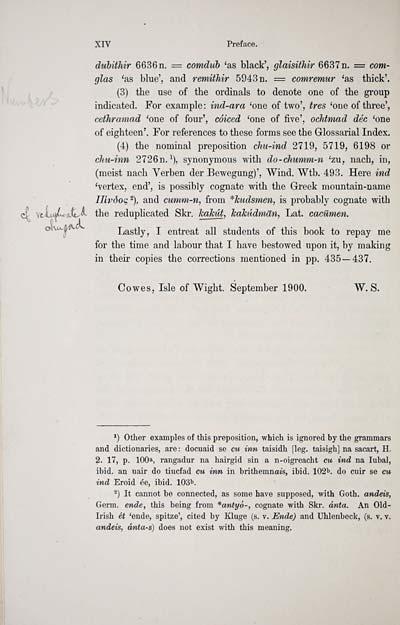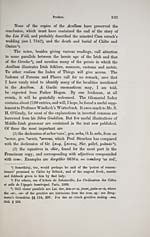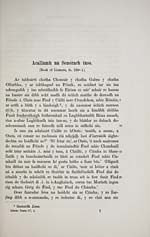Matheson Collection > Irische Texte
(18)
Download files
Complete book:
Individual page:
Thumbnail gallery: Grid view | List view

XIV Preface.
dubithir 6636 n. = comduh 'as black', glaisithir 6637 n. = com-
glas 'as blue', and remitJiir 5943 n. = comremur 'as thick'.
(3) the use of the ordinals to denote one of the group
indicated. For example : ind-ara 'one of two', tres 'one of three',
cethramad 'one of four', coked 'one of five', oclitmad dec 'one
of eighteen'. For references to these forms see the Glossarial Index.
(4) the nominal preposition cJiu-ind 2719, 5719, 6198 or
chu-inn 2726 n.^), synonymous with do-chumm-n 'zu, nach, in,
(meist nach Verben der Bewegung)', Wind. Wtb. 493. Here ind
'vertex, end', is possibly cognate with the Greek mountain-name
IJivóog ^), and cumm-n, from *Jcudsmen, is probably cognate with
ct Ytiufe^iüL^ the reduphcated Slcr. kahU, kaJmdmän, Lat. cacümen.
°*^^|^ Lastly, I entreat all students of this book to repay me
for the time and labour that I have bestowed upon it, by making
in their copies the corrections mentioned in pp. 485—437.
Cowes, Isle of Wight. September 1900. W. S.
*) Other examples of this preposition, which is ignored by the grammars
and dictionaries, are: docuaid se cu inn taisidh [leg. taisigh] na sacart, H.
2. 17, p. 100a, rangadur na hairgid sin a n-oigi-eacht cu ind na lubal,
ibid, an uair do tiucfad cu irm in brithemnais, ibid. 102^. do cuir se cu
ind Eroid ée, ibid. lOBb.
2) It cannot be connected, as some have supposed, with Goth, andeis,
Germ, ende, this being from *antyó-, cognate with Skr. ánta. An Old-
Irish et 'ende, spitze', cited by Kluge (s. v. Ende) and Uhlenbeck, (s. v. v.
andeis, ánta-s) does not exist with this meaning.
dubithir 6636 n. = comduh 'as black', glaisithir 6637 n. = com-
glas 'as blue', and remitJiir 5943 n. = comremur 'as thick'.
(3) the use of the ordinals to denote one of the group
indicated. For example : ind-ara 'one of two', tres 'one of three',
cethramad 'one of four', coked 'one of five', oclitmad dec 'one
of eighteen'. For references to these forms see the Glossarial Index.
(4) the nominal preposition cJiu-ind 2719, 5719, 6198 or
chu-inn 2726 n.^), synonymous with do-chumm-n 'zu, nach, in,
(meist nach Verben der Bewegung)', Wind. Wtb. 493. Here ind
'vertex, end', is possibly cognate with the Greek mountain-name
IJivóog ^), and cumm-n, from *Jcudsmen, is probably cognate with
ct Ytiufe^iüL^ the reduphcated Slcr. kahU, kaJmdmän, Lat. cacümen.
°*^^|^ Lastly, I entreat all students of this book to repay me
for the time and labour that I have bestowed upon it, by making
in their copies the corrections mentioned in pp. 485—437.
Cowes, Isle of Wight. September 1900. W. S.
*) Other examples of this preposition, which is ignored by the grammars
and dictionaries, are: docuaid se cu inn taisidh [leg. taisigh] na sacart, H.
2. 17, p. 100a, rangadur na hairgid sin a n-oigi-eacht cu ind na lubal,
ibid, an uair do tiucfad cu irm in brithemnais, ibid. 102^. do cuir se cu
ind Eroid ée, ibid. lOBb.
2) It cannot be connected, as some have supposed, with Goth, andeis,
Germ, ende, this being from *antyó-, cognate with Skr. ánta. An Old-
Irish et 'ende, spitze', cited by Kluge (s. v. Ende) and Uhlenbeck, (s. v. v.
andeis, ánta-s) does not exist with this meaning.
Set display mode to: Large image | Transcription
Images and transcriptions on this page, including medium image downloads, may be used under the Creative Commons Attribution 4.0 International Licence unless otherwise stated. ![]()
| Early Gaelic Book Collections > Matheson Collection > Irische Texte > (18) |
|---|
| Permanent URL | https://digital.nls.uk/76494446 |
|---|
| Description | Items from a collection of 170 volumes relating to Gaelic matters. Mainly philological works in the Celtic and some non-Celtic languages. Some books extensively annotated by Angus Matheson, the first Professor of Celtic at Glasgow University. |
|---|
| Description | Selected items from five 'Special and Named Printed Collections'. Includes books in Gaelic and other Celtic languages, works about the Gaels, their languages, literature, culture and history. |
|---|

